A Comprehensive Report: Nestle's Supply Chain and Cultural Impact
VerifiedAdded on 2021/08/10
|12
|3258
|363
Report
AI Summary
This report provides a comprehensive analysis of Nestle's supply chain management and its organizational culture. It begins with a background on Nestle, its global presence, and its commitment to nutrition and wellness. The study examines the impact of Nestle's culture on its supply chain, emphasizing its decentralized structure and collaborative approach. The report details the objectives, research methodology (qualitative research using secondary data), and research design employed. Observations focus on Nestle's organizational culture, supply chain management practices, implemented strategies, and new product launches. Key findings highlight Nestle's strong organizational culture, the importance of safety, technology integration, and strategies like market expansion. The report also includes a supply chain network diagram and discusses strategies like marketing and innovation. Finally, the report examines the impact of Nestle's culture on its supply chain, emphasizing the importance of collaboration and shared values within the company.
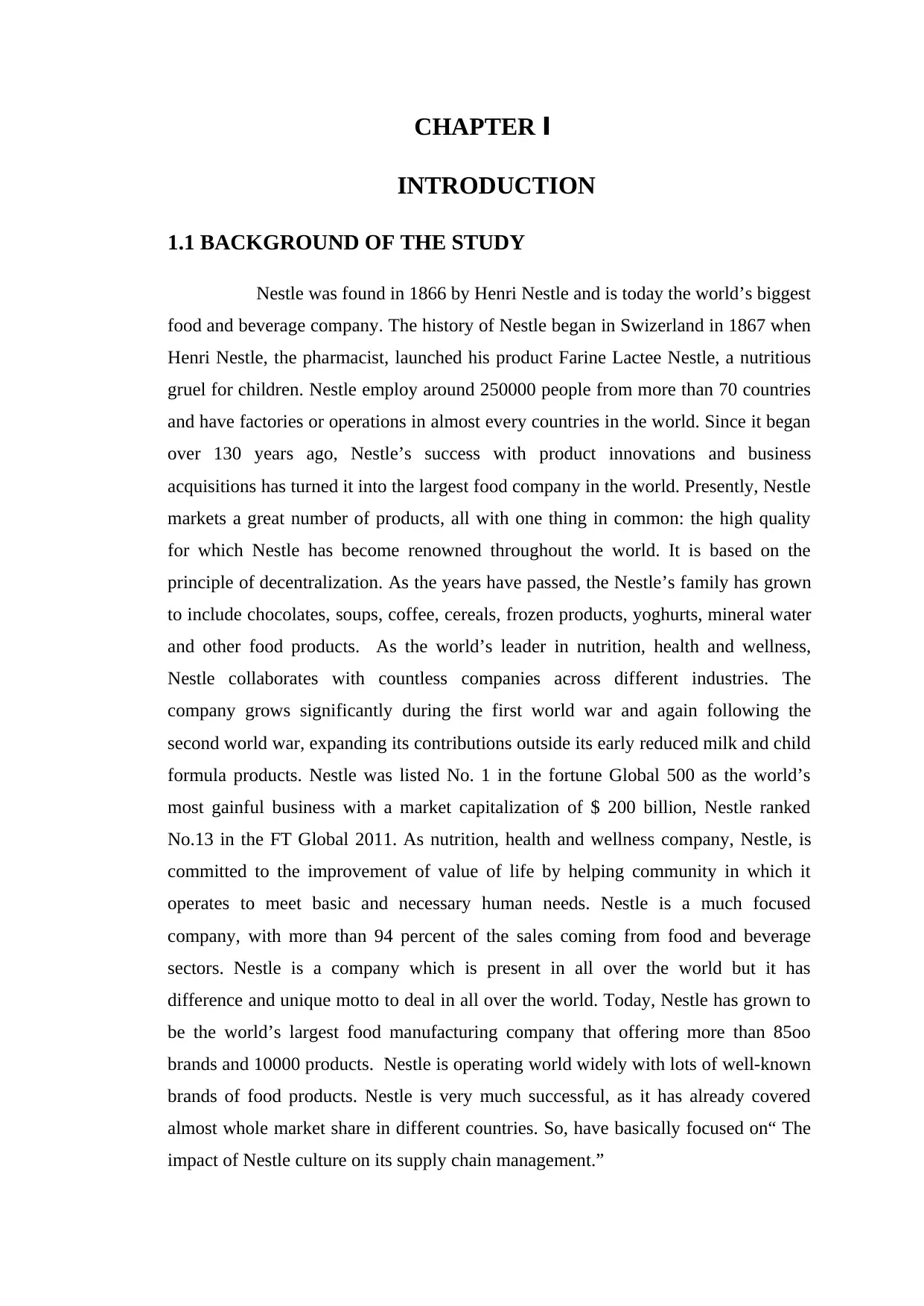
CHAPTER Ⅰ
INTRODUCTION
1.1 BACKGROUND OF THE STUDY
Nestle was found in 1866 by Henri Nestle and is today the world’s biggest
food and beverage company. The history of Nestle began in Swizerland in 1867 when
Henri Nestle, the pharmacist, launched his product Farine Lactee Nestle, a nutritious
gruel for children. Nestle employ around 250000 people from more than 70 countries
and have factories or operations in almost every countries in the world. Since it began
over 130 years ago, Nestle’s success with product innovations and business
acquisitions has turned it into the largest food company in the world. Presently, Nestle
markets a great number of products, all with one thing in common: the high quality
for which Nestle has become renowned throughout the world. It is based on the
principle of decentralization. As the years have passed, the Nestle’s family has grown
to include chocolates, soups, coffee, cereals, frozen products, yoghurts, mineral water
and other food products. As the world’s leader in nutrition, health and wellness,
Nestle collaborates with countless companies across different industries. The
company grows significantly during the first world war and again following the
second world war, expanding its contributions outside its early reduced milk and child
formula products. Nestle was listed No. 1 in the fortune Global 500 as the world’s
most gainful business with a market capitalization of $ 200 billion, Nestle ranked
No.13 in the FT Global 2011. As nutrition, health and wellness company, Nestle, is
committed to the improvement of value of life by helping community in which it
operates to meet basic and necessary human needs. Nestle is a much focused
company, with more than 94 percent of the sales coming from food and beverage
sectors. Nestle is a company which is present in all over the world but it has
difference and unique motto to deal in all over the world. Today, Nestle has grown to
be the world’s largest food manufacturing company that offering more than 85oo
brands and 10000 products. Nestle is operating world widely with lots of well-known
brands of food products. Nestle is very much successful, as it has already covered
almost whole market share in different countries. So, have basically focused on“ The
impact of Nestle culture on its supply chain management.”
INTRODUCTION
1.1 BACKGROUND OF THE STUDY
Nestle was found in 1866 by Henri Nestle and is today the world’s biggest
food and beverage company. The history of Nestle began in Swizerland in 1867 when
Henri Nestle, the pharmacist, launched his product Farine Lactee Nestle, a nutritious
gruel for children. Nestle employ around 250000 people from more than 70 countries
and have factories or operations in almost every countries in the world. Since it began
over 130 years ago, Nestle’s success with product innovations and business
acquisitions has turned it into the largest food company in the world. Presently, Nestle
markets a great number of products, all with one thing in common: the high quality
for which Nestle has become renowned throughout the world. It is based on the
principle of decentralization. As the years have passed, the Nestle’s family has grown
to include chocolates, soups, coffee, cereals, frozen products, yoghurts, mineral water
and other food products. As the world’s leader in nutrition, health and wellness,
Nestle collaborates with countless companies across different industries. The
company grows significantly during the first world war and again following the
second world war, expanding its contributions outside its early reduced milk and child
formula products. Nestle was listed No. 1 in the fortune Global 500 as the world’s
most gainful business with a market capitalization of $ 200 billion, Nestle ranked
No.13 in the FT Global 2011. As nutrition, health and wellness company, Nestle, is
committed to the improvement of value of life by helping community in which it
operates to meet basic and necessary human needs. Nestle is a much focused
company, with more than 94 percent of the sales coming from food and beverage
sectors. Nestle is a company which is present in all over the world but it has
difference and unique motto to deal in all over the world. Today, Nestle has grown to
be the world’s largest food manufacturing company that offering more than 85oo
brands and 10000 products. Nestle is operating world widely with lots of well-known
brands of food products. Nestle is very much successful, as it has already covered
almost whole market share in different countries. So, have basically focused on“ The
impact of Nestle culture on its supply chain management.”
Paraphrase This Document
Need a fresh take? Get an instant paraphrase of this document with our AI Paraphraser
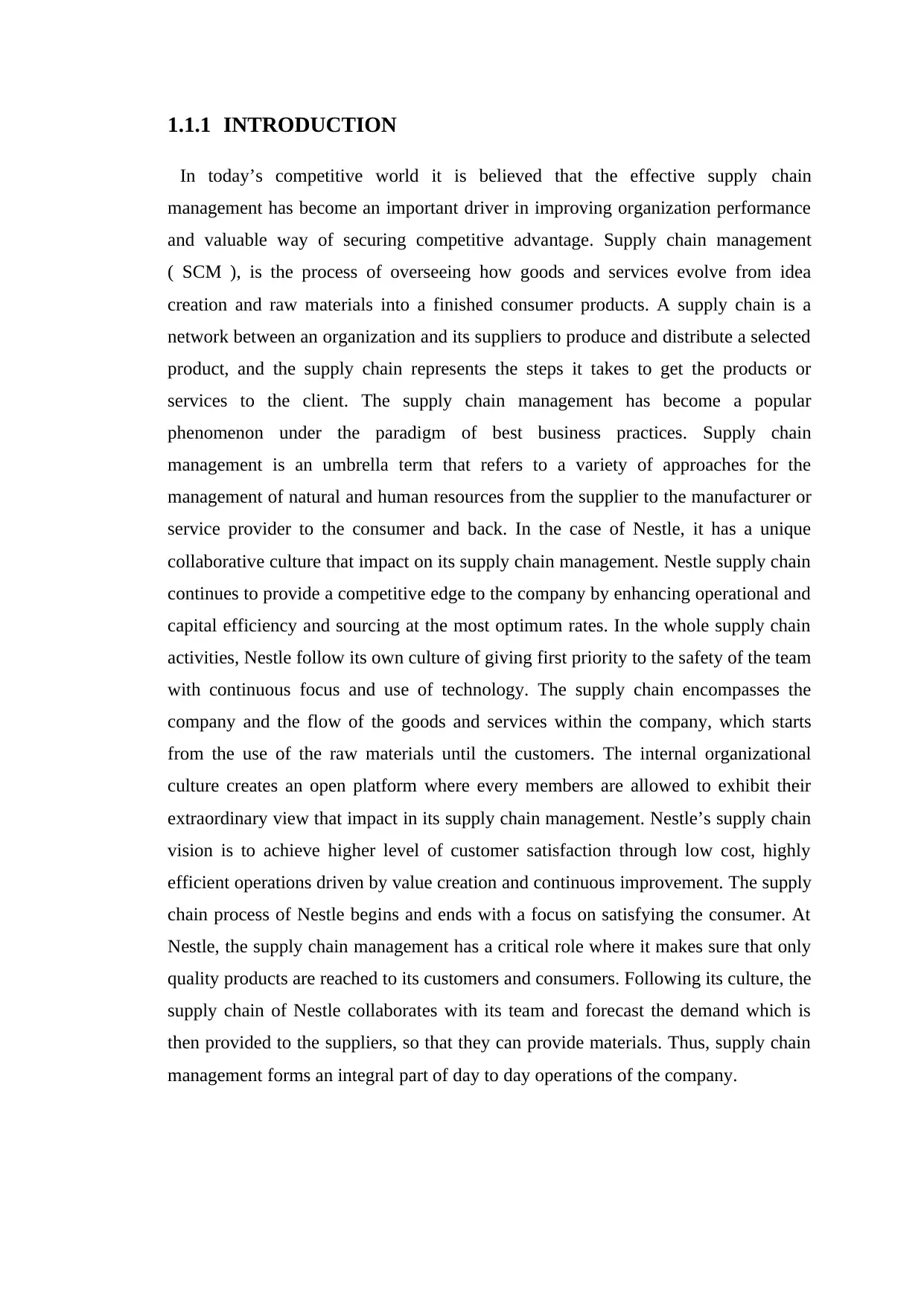
1.1.1 INTRODUCTION
In today’s competitive world it is believed that the effective supply chain
management has become an important driver in improving organization performance
and valuable way of securing competitive advantage. Supply chain management
( SCM ), is the process of overseeing how goods and services evolve from idea
creation and raw materials into a finished consumer products. A supply chain is a
network between an organization and its suppliers to produce and distribute a selected
product, and the supply chain represents the steps it takes to get the products or
services to the client. The supply chain management has become a popular
phenomenon under the paradigm of best business practices. Supply chain
management is an umbrella term that refers to a variety of approaches for the
management of natural and human resources from the supplier to the manufacturer or
service provider to the consumer and back. In the case of Nestle, it has a unique
collaborative culture that impact on its supply chain management. Nestle supply chain
continues to provide a competitive edge to the company by enhancing operational and
capital efficiency and sourcing at the most optimum rates. In the whole supply chain
activities, Nestle follow its own culture of giving first priority to the safety of the team
with continuous focus and use of technology. The supply chain encompasses the
company and the flow of the goods and services within the company, which starts
from the use of the raw materials until the customers. The internal organizational
culture creates an open platform where every members are allowed to exhibit their
extraordinary view that impact in its supply chain management. Nestle’s supply chain
vision is to achieve higher level of customer satisfaction through low cost, highly
efficient operations driven by value creation and continuous improvement. The supply
chain process of Nestle begins and ends with a focus on satisfying the consumer. At
Nestle, the supply chain management has a critical role where it makes sure that only
quality products are reached to its customers and consumers. Following its culture, the
supply chain of Nestle collaborates with its team and forecast the demand which is
then provided to the suppliers, so that they can provide materials. Thus, supply chain
management forms an integral part of day to day operations of the company.
In today’s competitive world it is believed that the effective supply chain
management has become an important driver in improving organization performance
and valuable way of securing competitive advantage. Supply chain management
( SCM ), is the process of overseeing how goods and services evolve from idea
creation and raw materials into a finished consumer products. A supply chain is a
network between an organization and its suppliers to produce and distribute a selected
product, and the supply chain represents the steps it takes to get the products or
services to the client. The supply chain management has become a popular
phenomenon under the paradigm of best business practices. Supply chain
management is an umbrella term that refers to a variety of approaches for the
management of natural and human resources from the supplier to the manufacturer or
service provider to the consumer and back. In the case of Nestle, it has a unique
collaborative culture that impact on its supply chain management. Nestle supply chain
continues to provide a competitive edge to the company by enhancing operational and
capital efficiency and sourcing at the most optimum rates. In the whole supply chain
activities, Nestle follow its own culture of giving first priority to the safety of the team
with continuous focus and use of technology. The supply chain encompasses the
company and the flow of the goods and services within the company, which starts
from the use of the raw materials until the customers. The internal organizational
culture creates an open platform where every members are allowed to exhibit their
extraordinary view that impact in its supply chain management. Nestle’s supply chain
vision is to achieve higher level of customer satisfaction through low cost, highly
efficient operations driven by value creation and continuous improvement. The supply
chain process of Nestle begins and ends with a focus on satisfying the consumer. At
Nestle, the supply chain management has a critical role where it makes sure that only
quality products are reached to its customers and consumers. Following its culture, the
supply chain of Nestle collaborates with its team and forecast the demand which is
then provided to the suppliers, so that they can provide materials. Thus, supply chain
management forms an integral part of day to day operations of the company.
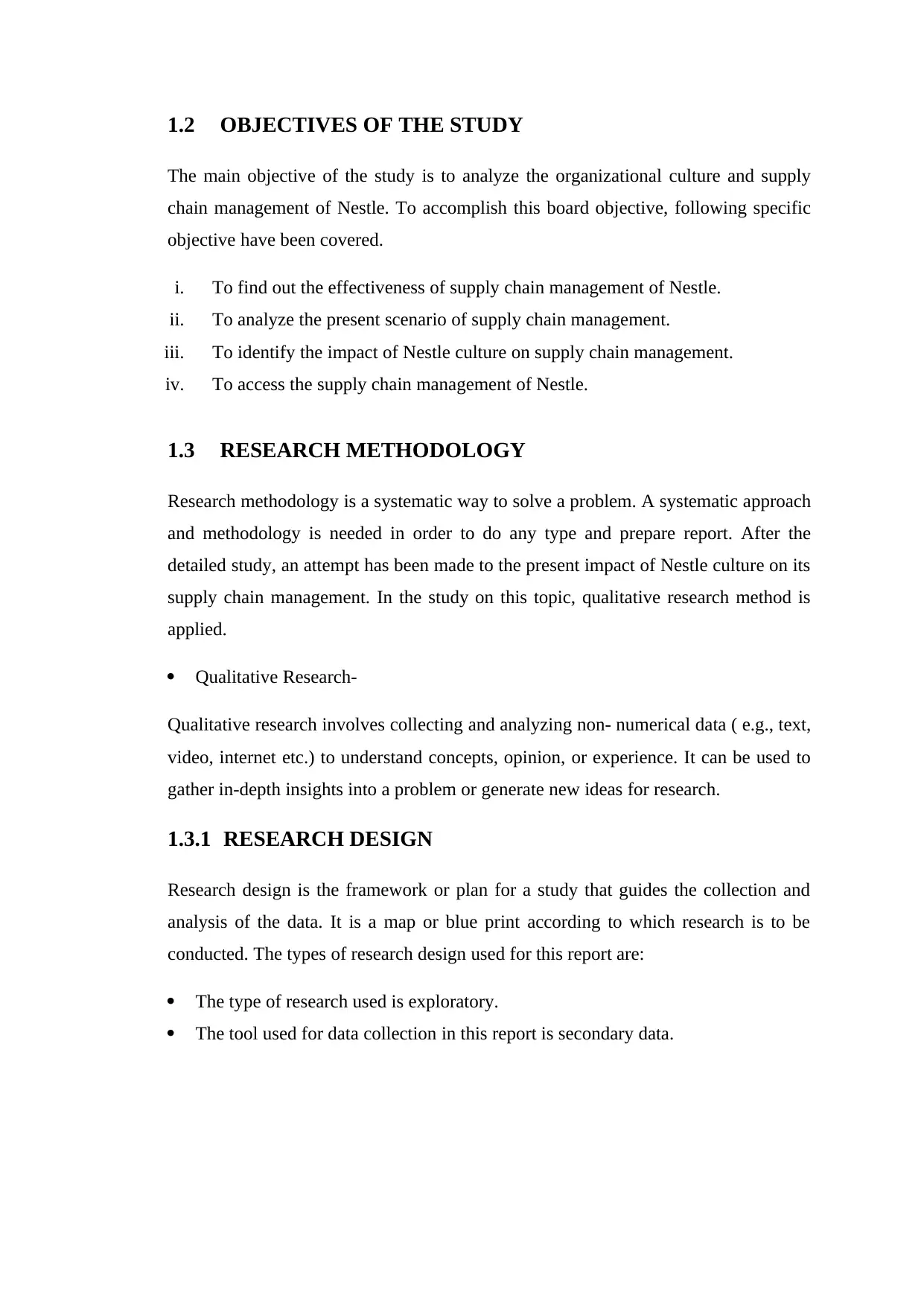
1.2 OBJECTIVES OF THE STUDY
The main objective of the study is to analyze the organizational culture and supply
chain management of Nestle. To accomplish this board objective, following specific
objective have been covered.
i. To find out the effectiveness of supply chain management of Nestle.
ii. To analyze the present scenario of supply chain management.
iii. To identify the impact of Nestle culture on supply chain management.
iv. To access the supply chain management of Nestle.
1.3 RESEARCH METHODOLOGY
Research methodology is a systematic way to solve a problem. A systematic approach
and methodology is needed in order to do any type and prepare report. After the
detailed study, an attempt has been made to the present impact of Nestle culture on its
supply chain management. In the study on this topic, qualitative research method is
applied.
Qualitative Research-
Qualitative research involves collecting and analyzing non- numerical data ( e.g., text,
video, internet etc.) to understand concepts, opinion, or experience. It can be used to
gather in-depth insights into a problem or generate new ideas for research.
1.3.1 RESEARCH DESIGN
Research design is the framework or plan for a study that guides the collection and
analysis of the data. It is a map or blue print according to which research is to be
conducted. The types of research design used for this report are:
The type of research used is exploratory.
The tool used for data collection in this report is secondary data.
The main objective of the study is to analyze the organizational culture and supply
chain management of Nestle. To accomplish this board objective, following specific
objective have been covered.
i. To find out the effectiveness of supply chain management of Nestle.
ii. To analyze the present scenario of supply chain management.
iii. To identify the impact of Nestle culture on supply chain management.
iv. To access the supply chain management of Nestle.
1.3 RESEARCH METHODOLOGY
Research methodology is a systematic way to solve a problem. A systematic approach
and methodology is needed in order to do any type and prepare report. After the
detailed study, an attempt has been made to the present impact of Nestle culture on its
supply chain management. In the study on this topic, qualitative research method is
applied.
Qualitative Research-
Qualitative research involves collecting and analyzing non- numerical data ( e.g., text,
video, internet etc.) to understand concepts, opinion, or experience. It can be used to
gather in-depth insights into a problem or generate new ideas for research.
1.3.1 RESEARCH DESIGN
Research design is the framework or plan for a study that guides the collection and
analysis of the data. It is a map or blue print according to which research is to be
conducted. The types of research design used for this report are:
The type of research used is exploratory.
The tool used for data collection in this report is secondary data.
⊘ This is a preview!⊘
Do you want full access?
Subscribe today to unlock all pages.

Trusted by 1+ million students worldwide
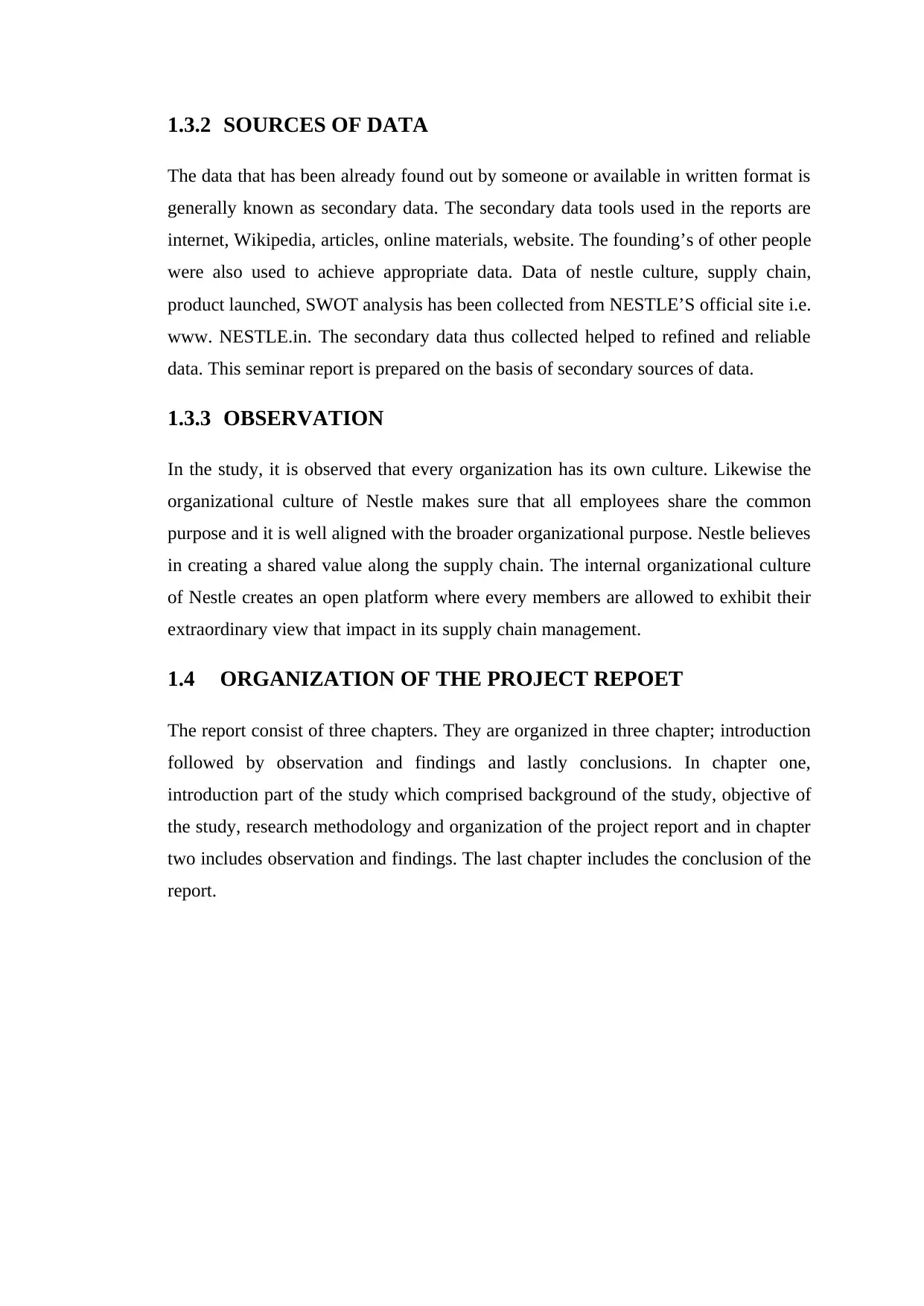
1.3.2 SOURCES OF DATA
The data that has been already found out by someone or available in written format is
generally known as secondary data. The secondary data tools used in the reports are
internet, Wikipedia, articles, online materials, website. The founding’s of other people
were also used to achieve appropriate data. Data of nestle culture, supply chain,
product launched, SWOT analysis has been collected from NESTLE’S official site i.e.
www. NESTLE.in. The secondary data thus collected helped to refined and reliable
data. This seminar report is prepared on the basis of secondary sources of data.
1.3.3 OBSERVATION
In the study, it is observed that every organization has its own culture. Likewise the
organizational culture of Nestle makes sure that all employees share the common
purpose and it is well aligned with the broader organizational purpose. Nestle believes
in creating a shared value along the supply chain. The internal organizational culture
of Nestle creates an open platform where every members are allowed to exhibit their
extraordinary view that impact in its supply chain management.
1.4 ORGANIZATION OF THE PROJECT REPOET
The report consist of three chapters. They are organized in three chapter; introduction
followed by observation and findings and lastly conclusions. In chapter one,
introduction part of the study which comprised background of the study, objective of
the study, research methodology and organization of the project report and in chapter
two includes observation and findings. The last chapter includes the conclusion of the
report.
The data that has been already found out by someone or available in written format is
generally known as secondary data. The secondary data tools used in the reports are
internet, Wikipedia, articles, online materials, website. The founding’s of other people
were also used to achieve appropriate data. Data of nestle culture, supply chain,
product launched, SWOT analysis has been collected from NESTLE’S official site i.e.
www. NESTLE.in. The secondary data thus collected helped to refined and reliable
data. This seminar report is prepared on the basis of secondary sources of data.
1.3.3 OBSERVATION
In the study, it is observed that every organization has its own culture. Likewise the
organizational culture of Nestle makes sure that all employees share the common
purpose and it is well aligned with the broader organizational purpose. Nestle believes
in creating a shared value along the supply chain. The internal organizational culture
of Nestle creates an open platform where every members are allowed to exhibit their
extraordinary view that impact in its supply chain management.
1.4 ORGANIZATION OF THE PROJECT REPOET
The report consist of three chapters. They are organized in three chapter; introduction
followed by observation and findings and lastly conclusions. In chapter one,
introduction part of the study which comprised background of the study, objective of
the study, research methodology and organization of the project report and in chapter
two includes observation and findings. The last chapter includes the conclusion of the
report.
Paraphrase This Document
Need a fresh take? Get an instant paraphrase of this document with our AI Paraphraser


CHAPTER Ⅱ
OBSERVATION AND FINDING
2.1 OBSERVATION
Observation in this report is made on organizational culture of Nestle, supply chain
management of Nestle, its SWOT analysis, strategies implemented, its new product
launched and impact of organizational culture on supply chain management.
2.1.1 ORGANIZATIONAL CULTURE OF NESTLE.
Organizational culture is defined as the guiding beliefs, norms and values of workers
on how work is done (Yazici, 2007). Nestle organizational culture has well-
constructed business culture which is reflected by the business logo itself. The logo
“Good Food Good Life” which is always attached to its products is the main guidance
for every activity within the company. The company culture which is related its
people structure. In regard to organizational culture, Nestle practices an open gate
policy, which has over the years been one of their strong points. It believes that every
single company, no matter where in the world it operates, ought to be fully integrated
into its own culture. In the study, it is observed that every organization has its own
culture. Likewise the organizational culture of Nestle makes sure that all employees
share the common purpose and it is well aligned with the broader organizational
purpose. Diversity and inclusion are an integral part of the Nestle culture. Nestle
believes in creating a shared value along the supply chain. The internal organizational
culture of Nestle creates an open platform where every members are allowed to
exhibit their extraordinary view that impact in its supply chain management.
Company focuses on collectivism and performance orientation attitude to encourage
employees to work hard (Ali et al, 2009). Nestle has successfully created a strong
organizational culture that is deeply embedded and widely accepted by its highly
diversified workforce. It has used its organizational culture as a tool to gain strategic
benefit and manage its supply chain. Nestle organizational culture revels that the
company is more closely related to the disciplined work culture with vertical
hierarchy and tall structure. Thus Nestle’s organizational is more internally than
externally driven. The internally driven culture has enabled the organization to use its
ethical brand image as a tool to get a strong competitive edge over rival firms.
OBSERVATION AND FINDING
2.1 OBSERVATION
Observation in this report is made on organizational culture of Nestle, supply chain
management of Nestle, its SWOT analysis, strategies implemented, its new product
launched and impact of organizational culture on supply chain management.
2.1.1 ORGANIZATIONAL CULTURE OF NESTLE.
Organizational culture is defined as the guiding beliefs, norms and values of workers
on how work is done (Yazici, 2007). Nestle organizational culture has well-
constructed business culture which is reflected by the business logo itself. The logo
“Good Food Good Life” which is always attached to its products is the main guidance
for every activity within the company. The company culture which is related its
people structure. In regard to organizational culture, Nestle practices an open gate
policy, which has over the years been one of their strong points. It believes that every
single company, no matter where in the world it operates, ought to be fully integrated
into its own culture. In the study, it is observed that every organization has its own
culture. Likewise the organizational culture of Nestle makes sure that all employees
share the common purpose and it is well aligned with the broader organizational
purpose. Diversity and inclusion are an integral part of the Nestle culture. Nestle
believes in creating a shared value along the supply chain. The internal organizational
culture of Nestle creates an open platform where every members are allowed to
exhibit their extraordinary view that impact in its supply chain management.
Company focuses on collectivism and performance orientation attitude to encourage
employees to work hard (Ali et al, 2009). Nestle has successfully created a strong
organizational culture that is deeply embedded and widely accepted by its highly
diversified workforce. It has used its organizational culture as a tool to gain strategic
benefit and manage its supply chain. Nestle organizational culture revels that the
company is more closely related to the disciplined work culture with vertical
hierarchy and tall structure. Thus Nestle’s organizational is more internally than
externally driven. The internally driven culture has enabled the organization to use its
ethical brand image as a tool to get a strong competitive edge over rival firms.
⊘ This is a preview!⊘
Do you want full access?
Subscribe today to unlock all pages.

Trusted by 1+ million students worldwide

2.1.2 SUPPLY CHAIN MANAGEMENT OF NESTLE
Nestle supply chain continues to provide a competitive edge to the company by
enhancing operational and capital efficiency and sourcing at the most optimum rates.
In the whole supply chain activities, safety is the first priority of the team with
continuous focus and enhanced use of technology. Nestle has concentrated heavily on
streamlining and improving their supply chain management in order to make it more
dependable, more cost effective and most importantly, more responsive to market
needs. In the local surroundings, considering the infrastructure and cultural limitations
Nestle supply chain strives to achieve remarkable results (Nestle, 2016, pp. 38-40).
ensures the highest possible standards along the supply chain that starts from the raw
materials via packaging, distribution, to the consumers. The company activities that
take place in a supply chain transform raw materials to finished products, which are
subsequently delivered to the end customer. Nestle’s supply chain operates in a
complex manner. The process starts with farmers growing the crops, the cooperatives
managing the sales, and finally processors and manufacturers producing the final
products. The final products are distributed to the retailers and to the customers
respectively. The basis purpose of supply chain management of Nestle is to control
inventory by managing the flows of materials. The supply chain of Nestle, after the
production, is responsible for its safe storage and transportation to customers and
consumers demands on time. The Nestle’s supplier code establishes non- negotiable
minimum standards. The Nestle’s supplier code helps to implement commitment. The
company has explicit supply chain management policies, which is an obligation for
the supply chain partners in order to engage in business with Nestle. Technology in
supply chain has been ungraded over time enabling firms like Nestle to monitor
customer Take- Offs in a better way. Nestle now has a much more robust logistics
enabling it to deliver more frequent and low- volume drops to retailers and other
players in the supply chain network. Nestle’s typical supply chain network includes:
1. Sourcing and procurement.
2. Manufacturing
3. Distribution.
4. Retailing.
5. Customers.
Nestle supply chain continues to provide a competitive edge to the company by
enhancing operational and capital efficiency and sourcing at the most optimum rates.
In the whole supply chain activities, safety is the first priority of the team with
continuous focus and enhanced use of technology. Nestle has concentrated heavily on
streamlining and improving their supply chain management in order to make it more
dependable, more cost effective and most importantly, more responsive to market
needs. In the local surroundings, considering the infrastructure and cultural limitations
Nestle supply chain strives to achieve remarkable results (Nestle, 2016, pp. 38-40).
ensures the highest possible standards along the supply chain that starts from the raw
materials via packaging, distribution, to the consumers. The company activities that
take place in a supply chain transform raw materials to finished products, which are
subsequently delivered to the end customer. Nestle’s supply chain operates in a
complex manner. The process starts with farmers growing the crops, the cooperatives
managing the sales, and finally processors and manufacturers producing the final
products. The final products are distributed to the retailers and to the customers
respectively. The basis purpose of supply chain management of Nestle is to control
inventory by managing the flows of materials. The supply chain of Nestle, after the
production, is responsible for its safe storage and transportation to customers and
consumers demands on time. The Nestle’s supplier code establishes non- negotiable
minimum standards. The Nestle’s supplier code helps to implement commitment. The
company has explicit supply chain management policies, which is an obligation for
the supply chain partners in order to engage in business with Nestle. Technology in
supply chain has been ungraded over time enabling firms like Nestle to monitor
customer Take- Offs in a better way. Nestle now has a much more robust logistics
enabling it to deliver more frequent and low- volume drops to retailers and other
players in the supply chain network. Nestle’s typical supply chain network includes:
1. Sourcing and procurement.
2. Manufacturing
3. Distribution.
4. Retailing.
5. Customers.
Paraphrase This Document
Need a fresh take? Get an instant paraphrase of this document with our AI Paraphraser
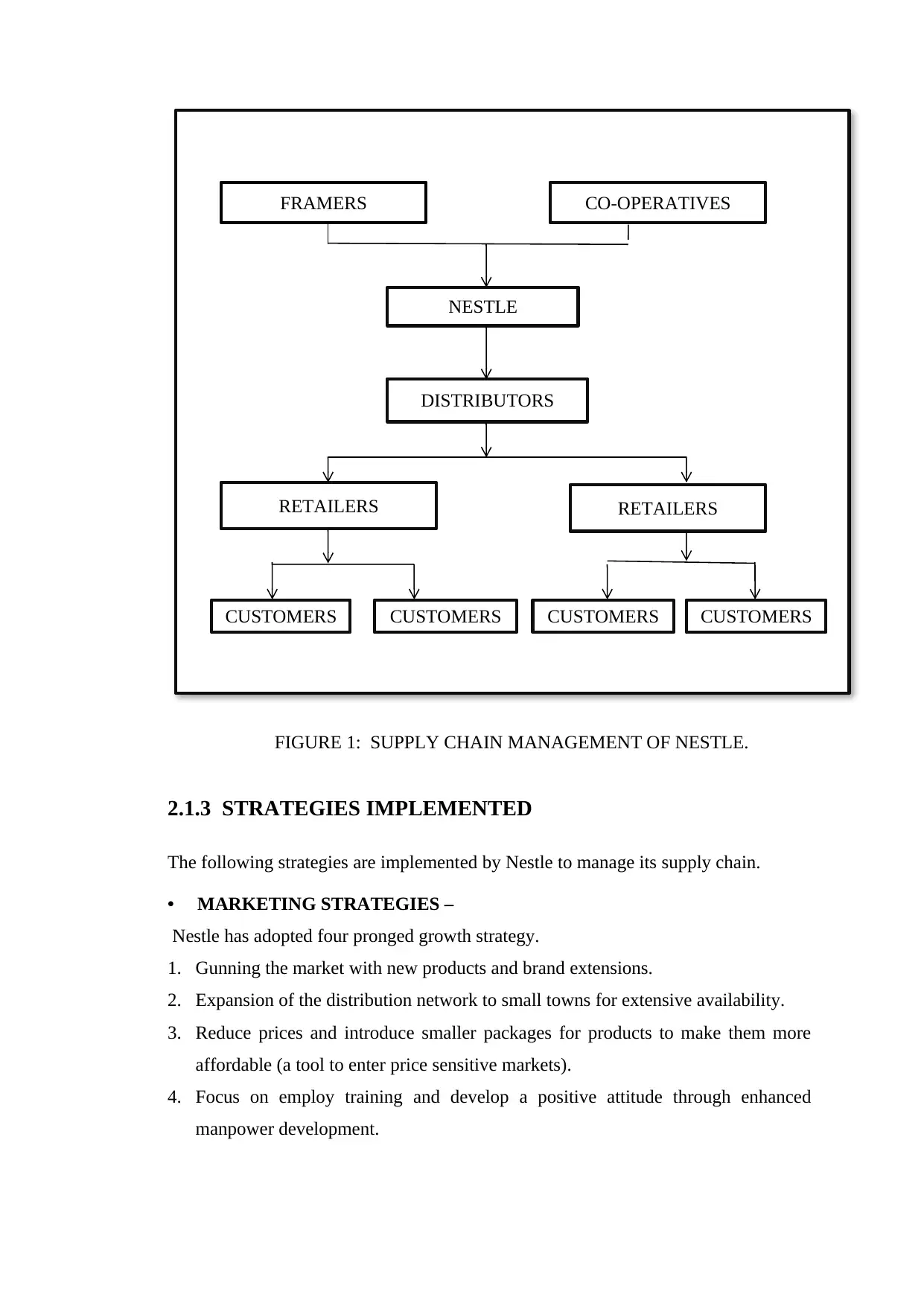
FIGURE 1: SUPPLY CHAIN MANAGEMENT OF NESTLE.
2.1.3 STRATEGIES IMPLEMENTED
The following strategies are implemented by Nestle to manage its supply chain.
• MARKETING STRATEGIES –
Nestle has adopted four pronged growth strategy.
1. Gunning the market with new products and brand extensions.
2. Expansion of the distribution network to small towns for extensive availability.
3. Reduce prices and introduce smaller packages for products to make them more
affordable (a tool to enter price sensitive markets).
4. Focus on employ training and develop a positive attitude through enhanced
manpower development.
FRAMERS CO-OPERATIVES
NESTLE
DISTRIBUTORS
RETAILERS RETAILERS
CUSTOMERS CUSTOMERS CUSTOMERS
S
CUSTOMERS
2.1.3 STRATEGIES IMPLEMENTED
The following strategies are implemented by Nestle to manage its supply chain.
• MARKETING STRATEGIES –
Nestle has adopted four pronged growth strategy.
1. Gunning the market with new products and brand extensions.
2. Expansion of the distribution network to small towns for extensive availability.
3. Reduce prices and introduce smaller packages for products to make them more
affordable (a tool to enter price sensitive markets).
4. Focus on employ training and develop a positive attitude through enhanced
manpower development.
FRAMERS CO-OPERATIVES
NESTLE
DISTRIBUTORS
RETAILERS RETAILERS
CUSTOMERS CUSTOMERS CUSTOMERS
S
CUSTOMERS

DISTRIBUTION STRATEGY –
For Nestle to be a leader in the food industry expanding the distribution network for
more retail outlets was a must. To meet this challenge, Nestle is working towards an
objective of increasing the retail base to 1,000,000 outlets by the year 2003. This
network is feasible as Nestle has a triangular distribution structure thus the span of
control is still retained.
• ADVERTISING STRATEGY –
Nestle, a cash rich company has plenty of marketing prowess. This can be credited to
a strong and sound advertising strategy. Nestle in the year 2002 had an advertisement
spending of Rs 43.3 crores ( net).
• GLOBAL BRAND STRATEGY -
Nestle has products that resonate all over the world under a unified brand. These
brands are unified under the Nestle banner, which delivered a value and reputation of
a “global food company” while the products delivered its own specific attributes.
Nestle has build global brands such as Nescafe, Nesquik, Nestea, Taster’s choice,
Haagen- Dazs. The global corporate brand was the brand platform for delivering
localized products and brand.
2.1.4 NEW PRODUCT LAUNCHED
To put all the product launched into perspective, Nestle now has 80 products
including various flavor and variants. Nestle still have a variety of new products in the
pipelines. It believes in slowly colonizing as much territory as fast as it can, adapting
to native conditions and then work at “holding off the advancing herds”.Nestle
products can be broadly classified into 5 main ranges, which are as follows.
Milk products.
Chocolate and Confectionery.
Beverages.
Culinary.
Food service.
For Nestle to be a leader in the food industry expanding the distribution network for
more retail outlets was a must. To meet this challenge, Nestle is working towards an
objective of increasing the retail base to 1,000,000 outlets by the year 2003. This
network is feasible as Nestle has a triangular distribution structure thus the span of
control is still retained.
• ADVERTISING STRATEGY –
Nestle, a cash rich company has plenty of marketing prowess. This can be credited to
a strong and sound advertising strategy. Nestle in the year 2002 had an advertisement
spending of Rs 43.3 crores ( net).
• GLOBAL BRAND STRATEGY -
Nestle has products that resonate all over the world under a unified brand. These
brands are unified under the Nestle banner, which delivered a value and reputation of
a “global food company” while the products delivered its own specific attributes.
Nestle has build global brands such as Nescafe, Nesquik, Nestea, Taster’s choice,
Haagen- Dazs. The global corporate brand was the brand platform for delivering
localized products and brand.
2.1.4 NEW PRODUCT LAUNCHED
To put all the product launched into perspective, Nestle now has 80 products
including various flavor and variants. Nestle still have a variety of new products in the
pipelines. It believes in slowly colonizing as much territory as fast as it can, adapting
to native conditions and then work at “holding off the advancing herds”.Nestle
products can be broadly classified into 5 main ranges, which are as follows.
Milk products.
Chocolate and Confectionery.
Beverages.
Culinary.
Food service.
⊘ This is a preview!⊘
Do you want full access?
Subscribe today to unlock all pages.

Trusted by 1+ million students worldwide
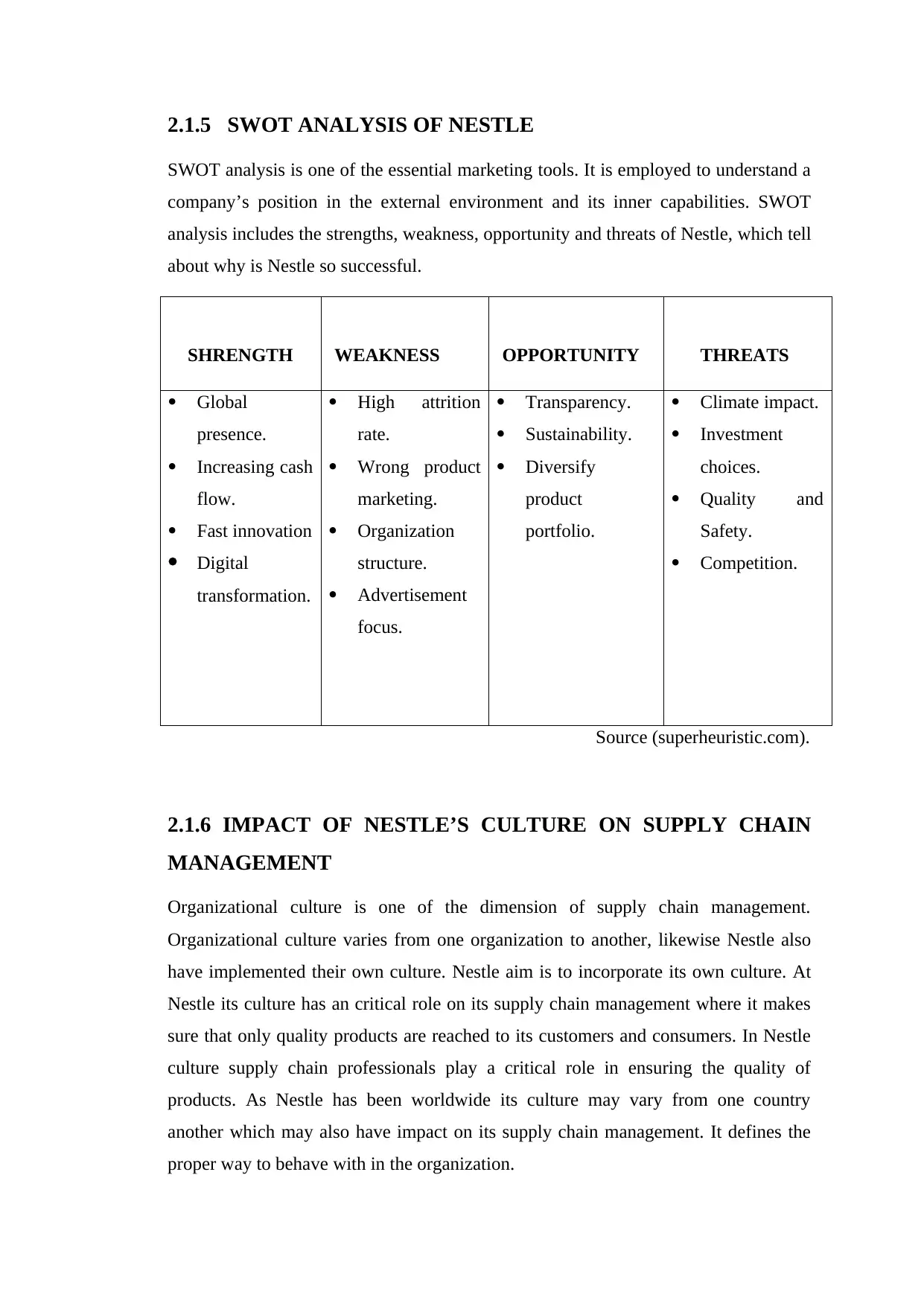
2.1.5 SWOT ANALYSIS OF NESTLE
SWOT analysis is one of the essential marketing tools. It is employed to understand a
company’s position in the external environment and its inner capabilities. SWOT
analysis includes the strengths, weakness, opportunity and threats of Nestle, which tell
about why is Nestle so successful.
SHRENGTH WEAKNESS OPPORTUNITY THREATS
Global
presence.
Increasing cash
flow.
Fast innovation
Digital
transformation.
High attrition
rate.
Wrong product
marketing.
Organization
structure.
Advertisement
focus.
Transparency.
Sustainability.
Diversify
product
portfolio.
Climate impact.
Investment
choices.
Quality and
Safety.
Competition.
Source (superheuristic.com).
2.1.6 IMPACT OF NESTLE’S CULTURE ON SUPPLY CHAIN
MANAGEMENT
Organizational culture is one of the dimension of supply chain management.
Organizational culture varies from one organization to another, likewise Nestle also
have implemented their own culture. Nestle aim is to incorporate its own culture. At
Nestle its culture has an critical role on its supply chain management where it makes
sure that only quality products are reached to its customers and consumers. In Nestle
culture supply chain professionals play a critical role in ensuring the quality of
products. As Nestle has been worldwide its culture may vary from one country
another which may also have impact on its supply chain management. It defines the
proper way to behave with in the organization.
SWOT analysis is one of the essential marketing tools. It is employed to understand a
company’s position in the external environment and its inner capabilities. SWOT
analysis includes the strengths, weakness, opportunity and threats of Nestle, which tell
about why is Nestle so successful.
SHRENGTH WEAKNESS OPPORTUNITY THREATS
Global
presence.
Increasing cash
flow.
Fast innovation
Digital
transformation.
High attrition
rate.
Wrong product
marketing.
Organization
structure.
Advertisement
focus.
Transparency.
Sustainability.
Diversify
product
portfolio.
Climate impact.
Investment
choices.
Quality and
Safety.
Competition.
Source (superheuristic.com).
2.1.6 IMPACT OF NESTLE’S CULTURE ON SUPPLY CHAIN
MANAGEMENT
Organizational culture is one of the dimension of supply chain management.
Organizational culture varies from one organization to another, likewise Nestle also
have implemented their own culture. Nestle aim is to incorporate its own culture. At
Nestle its culture has an critical role on its supply chain management where it makes
sure that only quality products are reached to its customers and consumers. In Nestle
culture supply chain professionals play a critical role in ensuring the quality of
products. As Nestle has been worldwide its culture may vary from one country
another which may also have impact on its supply chain management. It defines the
proper way to behave with in the organization.
Paraphrase This Document
Need a fresh take? Get an instant paraphrase of this document with our AI Paraphraser
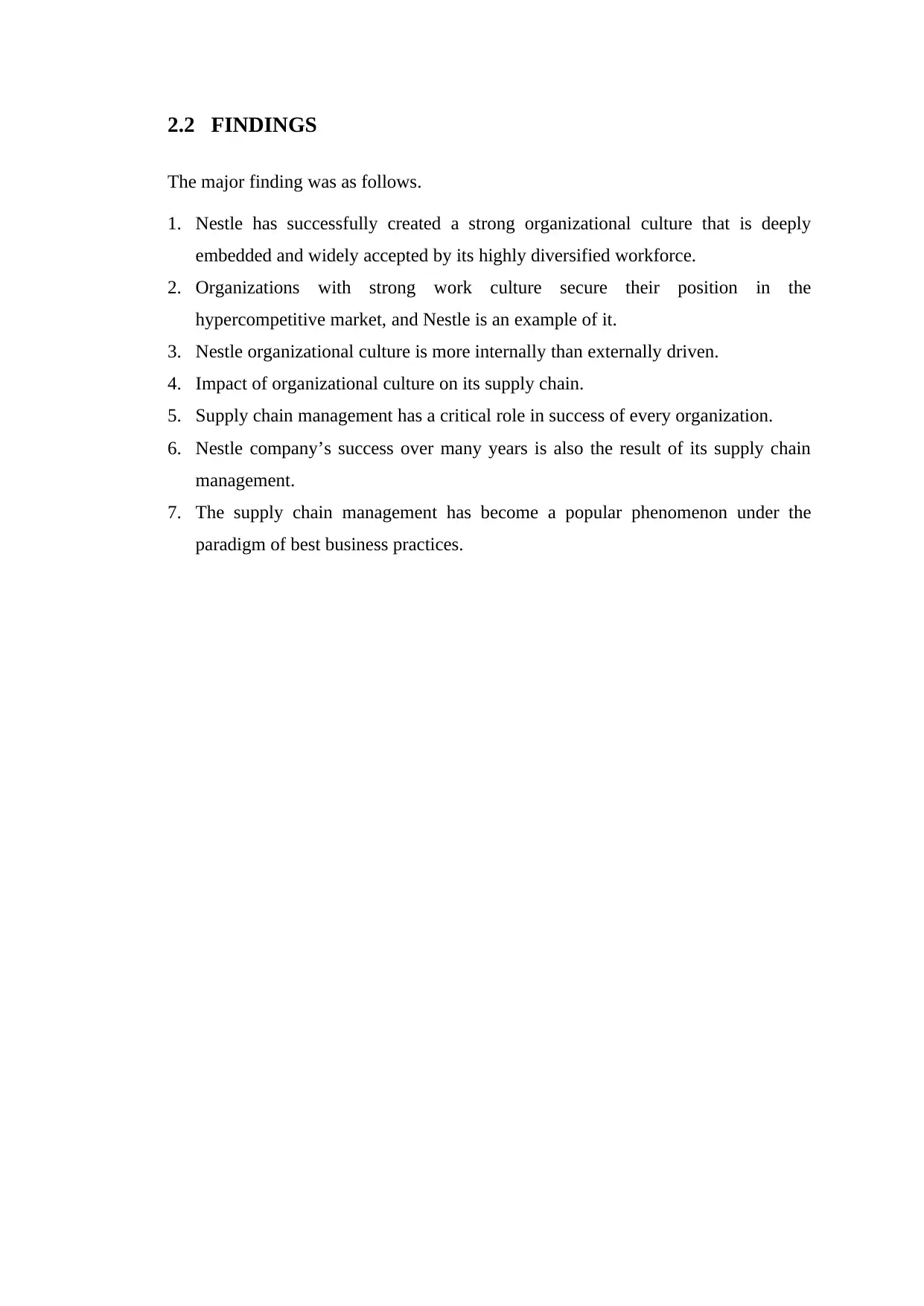
2.2 FINDINGS
The major finding was as follows.
1. Nestle has successfully created a strong organizational culture that is deeply
embedded and widely accepted by its highly diversified workforce.
2. Organizations with strong work culture secure their position in the
hypercompetitive market, and Nestle is an example of it.
3. Nestle organizational culture is more internally than externally driven.
4. Impact of organizational culture on its supply chain.
5. Supply chain management has a critical role in success of every organization.
6. Nestle company’s success over many years is also the result of its supply chain
management.
7. The supply chain management has become a popular phenomenon under the
paradigm of best business practices.
The major finding was as follows.
1. Nestle has successfully created a strong organizational culture that is deeply
embedded and widely accepted by its highly diversified workforce.
2. Organizations with strong work culture secure their position in the
hypercompetitive market, and Nestle is an example of it.
3. Nestle organizational culture is more internally than externally driven.
4. Impact of organizational culture on its supply chain.
5. Supply chain management has a critical role in success of every organization.
6. Nestle company’s success over many years is also the result of its supply chain
management.
7. The supply chain management has become a popular phenomenon under the
paradigm of best business practices.

CHAPTER Ⅲ
CONCLUSION
3.1 CONCLUSION
The report mainly gives an overview about the supply chain management of Nestle
and its organizational culture. The study finds out the Nestle organizational culture
which shows that the successful business organizations do not adopt an extreme
cultural orientation, but try to find the right equilibrium to develop the effective
culture. In the whole supply chain activity of Nestle safety is the first priority of the
team with continuous focus and enhanced use of technology. Through Nestle brands,
their products and the services they offer, they are helping and inspiring people to live
healthier life. Nestle has become very popular among the mass population of the
world. They are successful because of strong distribution network, through which
they are making their product available all over the world.
In this study it is found that the company has explicit supply chain management
policies, which is an obligation for the supply chain partner in order to engage in
business with Nestle. Nestle now has a much more robust logistics operation enabling
it to deliver more frequent and low-volume drops to retailers and other players in the
supply chain network. The study examines the impact of organizational culture on its
supply chain management. In view of this, the study concludes that understanding the
culture inherent in an organization is the vital to success of its supply chain
management. It is found that, at Nestle the supply chain management has a critical
role where it makes sure that only quality products are reached to its customers and
consumers. Thus, Both organizational culture and supply chain management forms an
integral part of the day to day operations of a company as well as it is very essential to
the company’s success and providing satisfaction to the customers.
CONCLUSION
3.1 CONCLUSION
The report mainly gives an overview about the supply chain management of Nestle
and its organizational culture. The study finds out the Nestle organizational culture
which shows that the successful business organizations do not adopt an extreme
cultural orientation, but try to find the right equilibrium to develop the effective
culture. In the whole supply chain activity of Nestle safety is the first priority of the
team with continuous focus and enhanced use of technology. Through Nestle brands,
their products and the services they offer, they are helping and inspiring people to live
healthier life. Nestle has become very popular among the mass population of the
world. They are successful because of strong distribution network, through which
they are making their product available all over the world.
In this study it is found that the company has explicit supply chain management
policies, which is an obligation for the supply chain partner in order to engage in
business with Nestle. Nestle now has a much more robust logistics operation enabling
it to deliver more frequent and low-volume drops to retailers and other players in the
supply chain network. The study examines the impact of organizational culture on its
supply chain management. In view of this, the study concludes that understanding the
culture inherent in an organization is the vital to success of its supply chain
management. It is found that, at Nestle the supply chain management has a critical
role where it makes sure that only quality products are reached to its customers and
consumers. Thus, Both organizational culture and supply chain management forms an
integral part of the day to day operations of a company as well as it is very essential to
the company’s success and providing satisfaction to the customers.
⊘ This is a preview!⊘
Do you want full access?
Subscribe today to unlock all pages.

Trusted by 1+ million students worldwide
1 out of 12
Related Documents
Your All-in-One AI-Powered Toolkit for Academic Success.
+13062052269
info@desklib.com
Available 24*7 on WhatsApp / Email
![[object Object]](/_next/static/media/star-bottom.7253800d.svg)
Unlock your academic potential
Copyright © 2020–2025 A2Z Services. All Rights Reserved. Developed and managed by ZUCOL.





